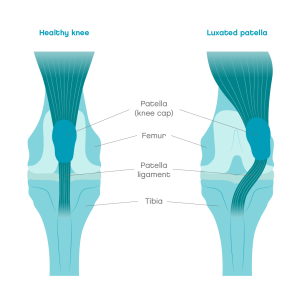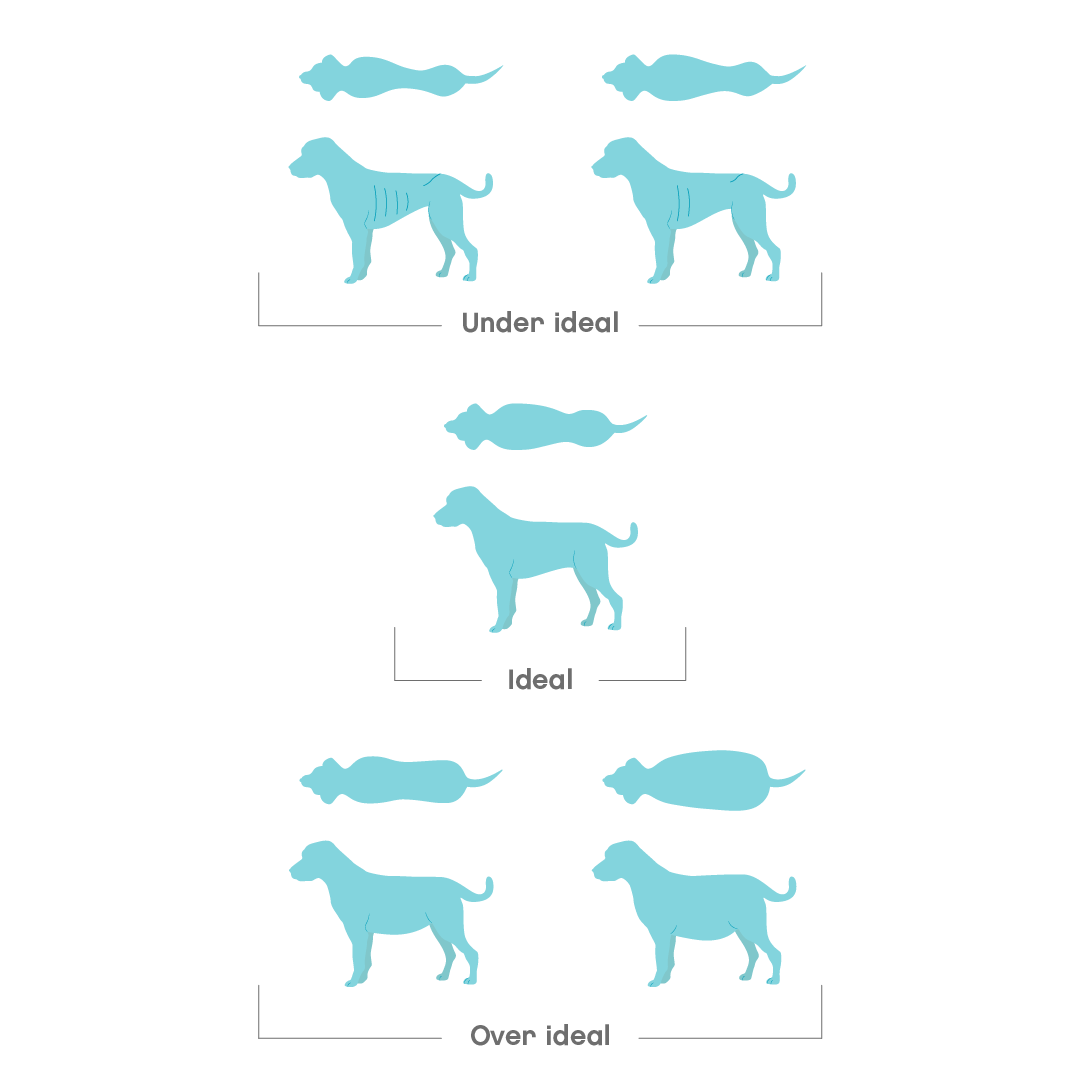Patellar luxation, also called a slipped or dislocating knee cap, occurs when the kneecap slides or pops out of place from the groove when the knee bends. Depending on the severity, the treatment can range from only exercise control to surgery.
Patellar luxation is a common orthopaedic condition describing kneecap dislocation. Most dogs with patella luxation develop arthritis in their knees later in life. Small breeds are more prone to this disease, but any dog or breed can have it.
Overview
What is patella luxation in dogs?
A healthy knee cap (patella) should never slide or pop out of the femoral grove. If so, we call it a luxating or dislocating patella.
Several factors may contribute to its occurrence, such as:
- Joint or leg structure changes that are inherited (hereditary).
- Growth related changes in the joint or leg (developmental abnormalities).
- Traumatic injury.
Approximately 50% of affected dogs have both knees involved.
For dogs that require surgery, outcomes are better if surgery is performed before advanced arthritis develops or additional ligament injury occurs, such as cruciate ligament disease.

Symptoms
Symptoms of patella luxation in dogs
Patellar dislocation symptoms vary greatly with the severity of the disease:
- Can be an incidental finding detected by your vet on a routine physical examination.
- Your dog may suddenly carry the leg up for a few steps (skipping).
- They can shake or extend the leg while walking or running.
- In young puppies with severe medial patellar luxation, the rear legs often have a “bow-legged” appearance that worsens with growth.
- Large breed dogs may have a “knocked-in knee” appearance.
Risk
Are some dogs more at risk of patella luxation than others?
Small breed dogs, such as Boston and Yorkshire Terriers, Bichon Frise, Chihuahuas, Pomeranians, and Miniature Poodles are more prone.
But it can also occur in large breeds, where Chinese Shar Peis, Flat-Coated Retrievers, Akitas, and Great Pyrenees are more likely to have it.
Common coexisting conditions
In addition to patella dislocation, the following conditions can occur:
- Arthritis: the knee cap may dislocate more often over time, damaging cartilage and eventually exposing the bone, causing arthritis and pain.
- Cranial cruciate ligament disease: ligaments in the knee may become strained, ultimately leading to rupture of the cranial cruciate ligament. <link to Cranial cruciate ligament disease>
- Tendinitis: inflammation of knee ligaments.
- Limb deformities: in puppies, the abnormal position of the patella may also lead to serious bone deformation of the leg.
Diagnosis
How is patella luxation diagnosed?
Your vet will do a hands-on orthopaedic examination and feel the patella move out of place. Then they will grade it based on its severity.
Grade 1: The patella can slip out of place with hand manipulation but can easily be placed back in position. This grade doesn’t usually cause much of a problem.
Grade 2: The patella will occasionally slip out of place during your dog’s normal movement but can easily be placed back in position.
Grade 3: The patella is out of place most of the time but can be moved back into normal position.
Grade 4: The patella is out of place and cannot be moved back into normal position.
Radiographs (x-rays) may be necessary to assess your dog’s condition and rule out other problems. Sometimes, CT scans are also necessary.
Vet treatment
Vet treatment for dogs with patella luxation
Your vet might recommend medical treatment and/or surgery based on your dog’s needs:
Medical management
- Medication to control inflammation and pain.
- Joint supplements and other arthritis management medications. Diet and exercise management: Weight control will also help to reduce pain.
- Additional treatments, such as physiotherapy, acupuncture, massage, stem cell therapy, and laser therapy, can be beneficial.
- We have an article on arthritis that offers more information about joint supplements and how to find qualified professionals to help you.
Surgical treatment
- Surgery may be recommended for those experiencing chronic pain or dogs that have developed a grade 3 or 4 luxating patella. In some cases, dogs with grade 2 luxations may also benefit from surgery. Referral to a specialist vet is usually necessary.
- The vet may recommend the following surgeries:
- Tibial tuberosity transposition
- Distal femoral varus osteotomy
- Trochlear block recession
- Soft tissue reconstruction
Home treatment
Home management of a dog with patella luxation
Follow your vet’s recommendation and exercise restriction plan.
- If your dog had surgery, your vet’s plan will be very detailed for the first 6-8 weeks.
- Keep your dog rested by using a cage or leaving them in small rooms of the house with no access to high furniture (sofa or bed).
- Keep their minds busy by feeding them in slow feeders and play mats.
- Start physiotherapy as soon as possible and continue for the following 3-6 months. The sessions will change as the bone heals and the main goal changes.
- A healthy weight is essential. Check your dog’s body condition score below. Vet nurses can help with advice on weight loss.
Body Condition Scoring (BCS) in dogs
Body Condition Score (BCS) is a scale that gives a practical evaluation of the fat coverage of your dogs body. By checking how easy or not it is to feel certain bony areas of the body, a score is then produced. There are several scales, from 1 to 5 or 1 to 9. The ideal body condition lies in the middle, so either 3/5 or 5/9.
The body areas normally checked for fat coverage are:
1. ribs and spine
2. hips and shoulders
3. waist

Here are a few tips on how to do it.
With your pet in a standing position:
- Place your hands on the rib cage and gently feel for each rib, without pressing too hard
- Feel the waist and look from the top and the side (if you have a very furry breed, it may be harder to assess)
- Feel the spine, which runs down the middle of the back
- Feel the top of the hips and shoulders
Will your dog be able to exercise normally after patellar luxation surgery?
Your dog should be able to exercise normally after a reevaluation with your orthopaedic surgeon and physiotherapy. It takes at least 6-8 weeks.
What to expect when your dog has patella luxation?
Grade 1: Don’t often show symptoms or require treatment. However, they should be monitored to make sure their symptoms don’t get worse.
Grade 2: When managed carefully with the correct treatment, they often do extremely well and are able to live a happy, pain-free life.
Grades 3-4: Do well if they have corrective surgery. Unfortunately, without surgery, dogs with high-grade patella luxation tend to suffer from mobility problems and pain throughout their lives.
It’s important to be aware that even with treatment, most dogs with patella luxation develop arthritis in their knees later in life. Learn more about arthritis symptoms in our article or speak to a vet.
Prevention
How to prevent patella luxation
It’s not always possible to prevent this disease. Due to its inherited cause, we can avoid passing it on to future generations by not breeding dogs that have been diagnosed with patella luxation.
When to worry
When should you be worried about your dog with patella luxation?
If your dog was diagnosed with patella luxation, contact your local vet practice if they:
- Do not improve despite treatment.
- Keep limping, hopping, or walking abnormally.
- Struggle to run, jump, or use the stairs.
- Have vomiting, diarrhoea, or loss of appetite when medication has been prescribed.
Joii can help:
- If your dog had surgery and you need tips to keep them calm and rested at home.
- If your dog is vomiting, has diarrhoea, or has no appetite when medication has been prescribed.
- If you need help and advice on slowing the progression of arthritis.








